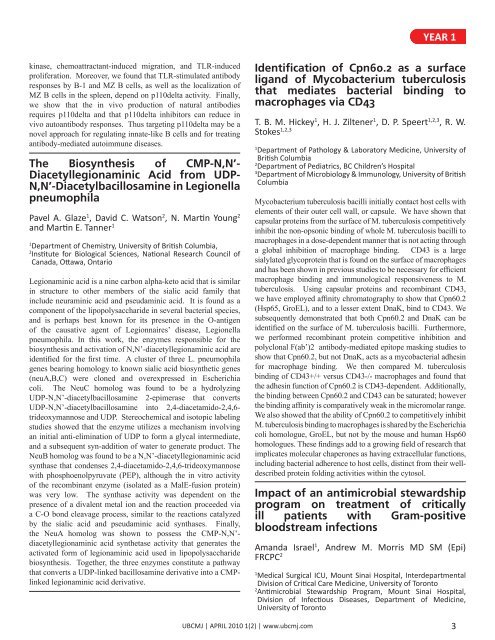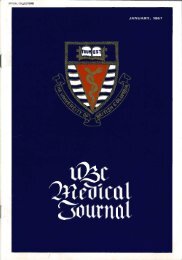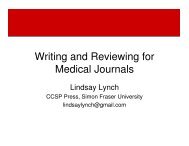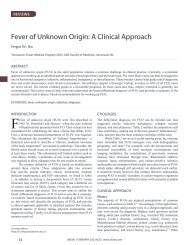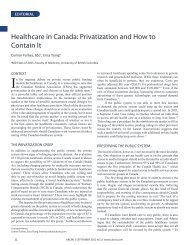Download full PDF - UBC Medical Journal
Download full PDF - UBC Medical Journal
Download full PDF - UBC Medical Journal
You also want an ePaper? Increase the reach of your titles
YUMPU automatically turns print PDFs into web optimized ePapers that Google loves.
YEAR 1<br />
kinase, chemoattractant-induced migration, and TLR-induced<br />
proliferation. Moreover, we found that TLR-stimulated antibody<br />
responses by B-1 and MZ B cells, as well as the localization of<br />
MZ B cells in the spleen, depend on p110delta activity. Finally,<br />
we show that the in vivo production of natural antibodies<br />
requires p110delta and that p110delta inhibitors can reduce in<br />
vivo autoantibody responses. Thus targeting p110delta may be a<br />
novel approach for regulating innate-like B cells and for treating<br />
antibody-mediated autoimmune diseases.<br />
The Biosynthesis of CMP-N,N’-<br />
Diacetyllegionaminic Acid from UDP-<br />
N,N’-Diacetylbacillosamine in Legionella<br />
pneumophila<br />
Pavel A. Glaze 1 , David C. Watson 2 , N. Martin Young 2<br />
and Martin E. Tanner 1<br />
1<br />
Department of Chemistry, University of British Columbia,<br />
2<br />
Institute for Biological Sciences, National Research Council of<br />
Canada, Ottawa, Ontario<br />
Legionaminic acid is a nine carbon alpha-keto acid that is similar<br />
in structure to other members of the sialic acid family that<br />
include neuraminic acid and pseudaminic acid. It is found as a<br />
component of the lipopolysaccharide in several bacterial species,<br />
and is perhaps best known for its presence in the O-antigen<br />
of the causative agent of Legionnaires’ disease, Legionella<br />
pneumophila. In this work, the enzymes responsible for the<br />
biosynthesis and activation of N,N’-diacetyllegionaminic acid are<br />
identified for the first time. A cluster of three L. pneumophila<br />
genes bearing homology to known sialic acid biosynthetic genes<br />
(neuA,B,C) were cloned and overexpressed in Escherichia<br />
coli. The NeuC homolog was found to be a hydrolyzing<br />
UDP-N,N’-diacetylbacillosamine 2-epimerase that converts<br />
UDP-N,N’-diacetylbacillosamine into 2,4-diacetamido-2,4,6-<br />
trideoxymannose and UDP. Stereochemical and isotopic labeling<br />
studies showed that the enzyme utilizes a mechanism involving<br />
an initial anti-elimination of UDP to form a glycal intermediate,<br />
and a subsequent syn-addition of water to generate product. The<br />
NeuB homolog was found to be a N,N’-diacetyllegionaminic acid<br />
synthase that condenses 2,4-diacetamido-2,4,6-trideoxymannose<br />
with phosphoenolpyruvate (PEP), although the in vitro activity<br />
of the recombinant enzyme (isolated as a MalE-fusion protein)<br />
was very low. The synthase activity was dependent on the<br />
presence of a divalent metal ion and the reaction proceeded via<br />
a C-O bond cleavage process, similar to the reactions catalyzed<br />
by the sialic acid and pseudaminic acid synthases. Finally,<br />
the NeuA homolog was shown to possess the CMP-N,N’-<br />
diacetyllegionaminic acid synthetase activity that generates the<br />
activated form of legionaminic acid used in lipopolysaccharide<br />
biosynthesis. Together, the three enzymes constitute a pathway<br />
that converts a UDP-linked bacillosamine derivative into a CMPlinked<br />
legionaminic acid derivative.<br />
Identification of Cpn60.2 as a surface<br />
ligand of Mycobacterium tuberculosis<br />
that mediates bacterial binding to<br />
macrophages via CD43<br />
T. B. M. Hickey 1 , H. J. Ziltener 1 , D. P. Speert 1,2,3 , R. W.<br />
Stokes 1,2,3<br />
1<br />
Department of Pathology & Laboratory Medicine, University of<br />
British Columbia<br />
2<br />
Department of Pediatrics, BC Children’s Hospital<br />
3<br />
Department of Microbiology & Immunology, University of British<br />
Columbia<br />
Mycobacterium tuberculosis bacilli initially contact host cells with<br />
elements of their outer cell wall, or capsule. We have shown that<br />
capsular proteins from the surface of M. tuberculosis competitively<br />
inhibit the non-opsonic binding of whole M. tuberculosis bacilli to<br />
macrophages in a dose-dependent manner that is not acting through<br />
a global inhibition of macrophage binding. CD43 is a large<br />
sialylated glycoprotein that is found on the surface of macrophages<br />
and has been shown in previous studies to be necessary for efficient<br />
macrophage binding and immunological responsiveness to M.<br />
tuberculosis. Using capsular proteins and recombinant CD43,<br />
we have employed affinity chromatography to show that Cpn60.2<br />
(Hsp65, GroEL), and to a lesser extent DnaK, bind to CD43. We<br />
subsequently demonstrated that both Cpn60.2 and DnaK can be<br />
identified on the surface of M. tuberculosis bacilli. Furthermore,<br />
we performed recombinant protein competitive inhibition and<br />
polyclonal F(ab’)2 antibody-mediated epitope masking studies to<br />
show that Cpn60.2, but not DnaK, acts as a mycobacterial adhesin<br />
for macrophage binding. We then compared M. tuberculosis<br />
binding of CD43+/+ versus CD43-/- macrophages and found that<br />
the adhesin function of Cpn60.2 is CD43-dependent. Additionally,<br />
the binding between Cpn60.2 and CD43 can be saturated; however<br />
the binding affinity is comparatively weak in the micromolar range.<br />
We also showed that the ability of Cpn60.2 to competitively inhibit<br />
M. tuberculosis binding to macrophages is shared by the Escherichia<br />
coli homologue, GroEL, but not by the mouse and human Hsp60<br />
homologues. These findings add to a growing field of research that<br />
implicates molecular chaperones as having extracellular functions,<br />
including bacterial adherence to host cells, distinct from their welldescribed<br />
protein folding activities within the cytosol.<br />
Impact of an antimicrobial stewardship<br />
program on treatment of critically<br />
ill patients with Gram-positive<br />
bloodstream infections<br />
Amanda Israel 1 , Andrew M. Morris MD SM (Epi)<br />
FRCPC 2<br />
1<br />
<strong>Medical</strong> Surgical ICU, Mount Sinai Hospital, Interdepartmental<br />
Division of Critical Care Medicine, University of Toronto<br />
2<br />
Antimicrobial Stewardship Program, Mount Sinai Hospital,<br />
Division of Infectious Diseases, Department of Medicine,<br />
University of Toronto<br />
<strong>UBC</strong>MJ | APRIL 2010 1(2) | www.ubcmj.com 3


